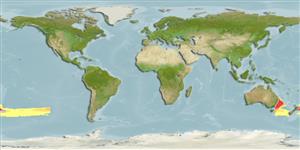>
Saccopharyngiformes (Swallowers and gulpers) >
Saccopharyngidae (Swallowers)
Etymology: Saccopharynx: Latin, sacculus = small bag + Greek, pharyngx = pharynx (Ref. 45335).
Eponymy: Dr Ernst Johannes Schmidt (1877–1933) was a Danish biologist who became the Director of the Laboratoire Carlsberg (1909–1933). [...] (Ref. 128868), visit book page.
Environment: milieu / climate zone / depth range / distribution range
Ecología
marino batipelágico. Deep-water
Southwest Pacific.
Tamaño / Peso / Age
Maturity: Lm ? range ? - ? cm
Life cycle and mating behavior
Madurez | Reproducción | Puesta | Huevos | Fecundidad | Larva
Paxton, J.R., D.F. Hoese, G.R. Allen and J.E. Hanley, 1989. Pisces. Petromyzontidae to Carangidae. Zoological Catalogue of Australia, Vol. 7. Australian Government Publishing Service, Canberra, 665 p. (Ref. 7300)
IUCN Red List Status (Ref. 130435: Version 2024-1)
Threat to humans
Harmless
Human uses
Herramientas
Special reports
Download XML
Fuentes de Internet
Estimates based on models
Preferred temperature (Ref.
123201): 1.1 - 1.9, mean 1.3 °C (based on 441 cells).
Phylogenetic diversity index (Ref.
82804): PD
50 = 0.5020 [Uniqueness, from 0.5 = low to 2.0 = high].
Bayesian length-weight: a=0.00102 (0.00046 - 0.00225), b=3.06 (2.88 - 3.24), in cm total length, based on all LWR estimates for this body shape (Ref.
93245).
Nivel trófico (Ref.
69278): 4.2 ±0.6 se; based on size and trophs of closest relatives
Fishing Vulnerability (Ref.
59153): High vulnerability (60 of 100).
